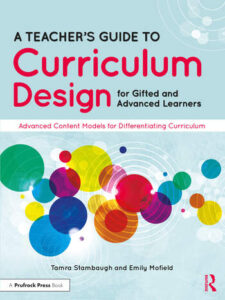Tools to Challenge Gifted and Advanced Learners
A Teacher’s Guide to Curriculum Design for Gifted and Advanced Learners: Advanced Content Models for Differentiating Curriculum
By Tamra Stambaugh and Emily Mofield
(Routledge/Prufrock, 2022 – Learn more)
Reviewed by Kim Rensch
 Meeting the needs of every single student in a classroom can be daunting. Meeting the needs of gifted learners can be especially challenging, which is why some teachers are likely to direct their precious resources toward meeting the needs of students they see struggling the most.
Meeting the needs of every single student in a classroom can be daunting. Meeting the needs of gifted learners can be especially challenging, which is why some teachers are likely to direct their precious resources toward meeting the needs of students they see struggling the most.
Take it from a teacher with gifted and talented certification: our gifted students will struggle just as much as any other student in our classroom if we teachers do not properly differentiate our curriculum.
 Boredom and apathy can take root when a student’s learning needs are not met. This is where we can use the help of teaching specialists trained in meeting the needs of gifted students. In the absence of such a colleague on our staff, we can turn to experts like Tamra Stambaugh and Emily Mofield for help.
Boredom and apathy can take root when a student’s learning needs are not met. This is where we can use the help of teaching specialists trained in meeting the needs of gifted students. In the absence of such a colleague on our staff, we can turn to experts like Tamra Stambaugh and Emily Mofield for help.
Their 2022 book from the Routledge/Prufrock imprint, A Teacher’s Guide to Curriculum Design for Gifted and Advanced Learners: Advanced Content Models for Differentiating Curriculum, is a useful guide for meeting the unique needs of advanced K-12 learners.
Not Just Another Differentiation Book
Many books on the topic of differentiation focus on the three ways to differentiate: product, process, and content. A Teacher’s Guide goes beyond these three to present content-specific graphic organizers and ready-made, reasonably low-prep learning experiences that an exhausted teacher could put into action for advanced learners.
Stambaugh and Mofield state at the end of chapter one that they “hope you find the models that follow to be simple tools for supporting students’ complex thinking” (3). They certainly deliver on this promise. The list of differentiated choice book projects on page 32 is in itself worth the price of admission for this book.
The Reading Experience
This is not a book that requires a cover-to-cover read in order for the learning experiences inside it to be implemented quickly. After a succinct chapter about developing talent in advanced learners and a meaty second chapter in which Stambaugh and Mofield define models for differentiation, chapters three through eight present models for differentiating instruction in English/language arts (broken into chapters for literary and informational texts), social studies, STEM, and art.
If a teacher’s content area is not represented in these chapters, there are learning activities that can be extrapolated from one content area to carry into a different content area. For example, music teachers might find some aspects of the literary texts chapter useful.
I will admit that there were some places in the second chapter that left me wishing for examples to illustrate the authors’ meaning, but these needs were met in subsequent chapters. I encourage any reader feeling bogged down by the concepts discussed in chapter two to flip to the models for differentiation chapter that best fits their discipline and spend some time exploring the charts and illustrations before returning to chapter two.
It is worth getting through the foundational content in chapter two to the subsequent models for differentiation chapters. These offer completed examples of the graphic organizers provided in the appendices (more on those later), suggestions for questions that require in-depth thinking opportunities for advanced learners, and even some sample advanced task ideas. The latter are key to helping teachers understand how depth and complexity are added to make grade-level tasks fit the needs of advanced students.
Powerful Appendices
Teachers of gifted and advanced learners know that graphic organizers can aid students doing complex thinking by organizing ideas in a visual way. The appendices at the end of A Teacher’s Guide are devoted to offering teachers powerful graphic organizers meant to assist students in analyzing and making connections.
When necessary, organizers are provided for both primary and secondary levels of learners. Language arts teachers will love the rhetorical analysis wheel guide, while visual arts teachers will appreciate the visual analysis wheel.
Words of Advice
While the graphic organizers and many of the other tools shared within A Teacher’s Guide could be adopted by a single teacher, I recommend sharing this book as a PLC or professional learning opportunity because more heads are better than one when making sense of the models of differentiation provided.
A team of teachers is also necessary to accomplish the work of chapter 8: Creating Interdisciplinary and Intradisciplinary Connections. This chapter features big questions that require an interdisciplinary approach akin to project based learning (PBL).
A Final Thought on This Book
Over the years I have consumed stacks of books about differentiation for gifted students. Each of these books has contributed in some way to my understanding of meeting the needs of advanced learners. Of all these books, Stambaugh and Mofield’s will likely get the most use in coming years because of its helpful graphic organizers, project ideas, and sample complex questions.
Any teacher will find something in this book to challenge their gifted and advanced learners.
Kim Rensch (@KJRensch) is a National Board Certified Teacher working as a member of the Gifted Services team for Fargo Public Schools in North Dakota. She is a Teacher-Consultant in the Red River Valley Writing Project and co-founder of the writing site My North Dakota Story. When she’s not doing something literacy- or school-related, Kim can be found spending time with her husband and their dogs, or with her many plants and flowers.

































